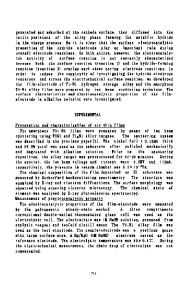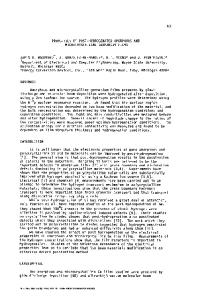Study of Oxidation Properties of Amorphous Si:B Films
- PDF / 496,344 Bytes
- 6 Pages / 420.48 x 639 pts Page_size
- 39 Downloads / 287 Views
STUDY OF OXIDATION PROPERTIES OF AMORPHOUS Si:B FILMS
G.-R. YANG*, T. C. NASON*, Y-J. WU*, B. Y TONG**, and S. K. WONG** * Center for Integrated Electronics and Physics Department, Rensselaer Polytechnic Institute, Troy, NY 12180 ** Center of Chemical Physics, University of Western Ontario, London, Ontario, N6A 5B7, Canada ABSTRACT Thin films of an amorphous silicon-boron alloy with boron content 1 - 50 at.% have been deposited by low pressure chemical vapor deposition (LPCVD). The boron content and film thickness of the samples were controlled by regulating the ratio of diborane and silane gases during the deposition. It was observed that the crystallization of the amorphous alloy took place at higher temperatures as boron concentration was increased. After a thermal oxidation was performed, the stoichiometry of the resulting oxide layers on various samples was determined by the secondary ion mass spectrometry and Auger depth profile methods. While the threshold temperature for thermal oxidation was determined to be inversely proportional to the boron concentration, the oxidation rate showed a dramatic increase with boron content. In particular, an alloy containing 30% boron was readily oxidized at 500 0 C. Mechanisms for the enhancement of oxidation consistent with stoichiometric and spectroscopic properties of the oxide layers are discussed. INTRODUCTION Because of the ubiquitous need for insulating materials in electronic devices, a variety of methods have been devised for fabricating silicon-based compound thin films [1-9]. Although thermally-grown silicon dioxide possesses excellent electronic properties, the usual oxidation process often requires temperatures in excess of 900 - 12000 C to achieve layers of sufficient thickness [10]. A great deal of effort has accordingly been devoted to developing materials capable of being oxidized or deposited at more moderate temperatures without undue sacrifice of electrical, chemical, and mechanical properties such as dielectric strength, film composition, and structural integrity [1,7,9]. Since grown compounds typically surpass deposited ones in these respects, various oxidizing environments and agents have been applied to the oxidation of crystalline silicon (c-Si) [6,9]. An alternative approach is the enhancement of oxidation by doping or alloying [2-5]. Low pressure chemical vapor deposition (LPCVD) is in general preferable to glow discharge for this purpose because of the comparative ease of heavy doping. In this paper we discuss in detail the oxidation of amorphous Si:B films deposited by LPCVD. The enhancement of oxidation rate by increasing boron content suggests applications in thin film transistors, bipolar devices, and MOS integrated circuit applications. Other film properties such as high and tailorable resistivity, high temperature stability, and high microhardness are consistent with this recommendation [11-17]. EXPERIMENTAL Amorphous a-Si l-x:Bx films with x ranging from 0.01 to 0.5 were prepared using an LPCVD system in which silane (Sil 4 ) and diboran
Data Loading...








